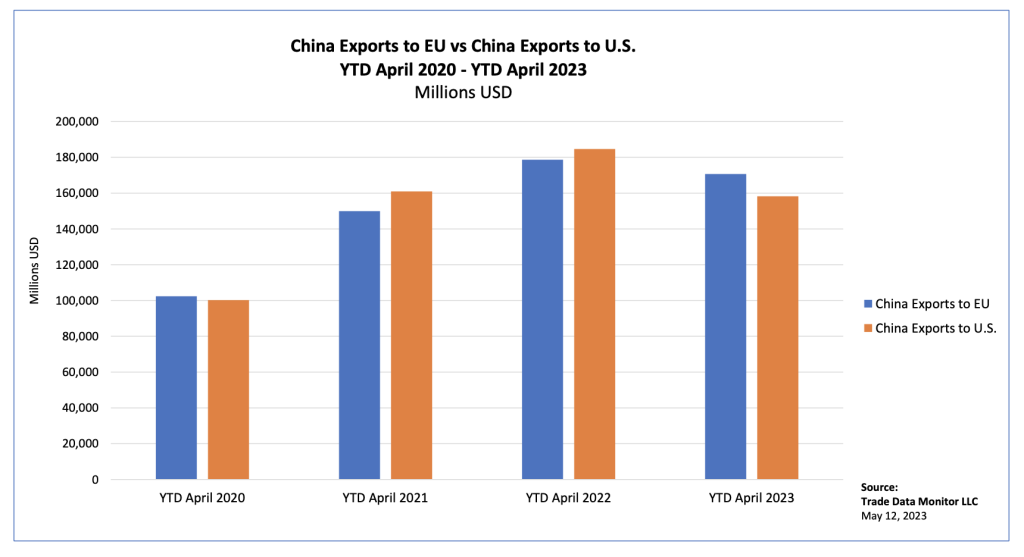There’s so much focus on the U.S.-China trade relationship and its frequent fireworks that it’s often forgotten that the European Union, still the world’s preeminent free-trade alliance, with 447 million consumers, is the better customer.
In April, exports to the European Union increased 4.1% year-on-year to $44.7 billion, while exports to the U.S. dropped 6.2% to $43 billion. Imports from the EU fell only 0.1% to $23.4 billion while imports from the U.S. declined 2.9% to $13.3 billion.
That’s part of a trend. For all of 2022, the EU imported $656.2 billion from China and exported $239.5 billion, while the U.S. imported $536.8 billion and exported $153.8 billion.
Overall, Chinese exports continued their modest recovery after the Covid-19 pandemic. Exports exceeded expectations, clicking up 8.5% in April to $295.4 billion, after increased 14.8% in March. Meanwhile, imports fell 7.9% to $205.2 billion. “China is past the fastest stage of its reopening,” Goldman Sachs analysts wrote in a note.

Consumer demand around the world is tepid right now, with the Federal Reserve and other central banks raising interest rates to tame inflation. The World Trade Organization now forecasts global trade to increase 1.7% in 2023, down from 2.7% in 2022, because it’s “weighed down by the effects of the war in Ukraine, stubbornly high inflation, tighter monetary policy and financial market uncertainty.”
At the same time, there’s a wave of protectionism roiling global trade that’s especially affected high-tech supply chains and semiconductor manufacturing, which have become the objects of a geopolitical chess game. The U.S. has promised heavy investments in its own new factories, while China has cut trade with high-tech Western allies such as South Korea. Chinese imports of high-tech products shrank 8.4% in April to $53.7 billion.
New export orders fell in April, according to a recent survey by China’s national statistics bureau. Beijing has forecast a GDP growth target in 2023 of around 5%.
And for that it’s depending more on Europe than the U.S. In 2022, the EU’s biggest import was electronics, followed by machinery, organic chemicals, cars and trucks, furniture, toys, and plastics.
Meanwhile, exports to ASEAN countries increased 5.6% to $46.2 billion and imports declined 6.7% to $30.7 billion. Exports to Vietnam, the Philippines and Indonesia fell, while shipments to Malaysia, Singapore and Thailand increased.
In some manufacturing sectors, exports picked up. Exports of footwear, for example, increased 14.1% to $4.3 billion. But in others, China showed that it’s retreating from global markets. Significantly, exports of high-tech products fell 5.8% to $68.1 billion, while exports of data processing equipment declined 17% to $15.2 billion.
In some industrial sectors, China is not competing as aggressively as it was in the first decade of this century. Exports of unwrought aluminium and aluminium products fell 35.4% to $1.6 billion.
However, it continues its campaign in global car markets. Exports of motor vehicles increased 195.7% to $8.3 billion. In another big-ticket manufacturing sector, exports of ships increased 79.2% to $2.2 billion.
China is importing more and more energy to fuel its richer large population and richer lifestyle. Imports of coal increased 72.7% by quantity to 40.7 million tons, and 33.2% by value to $5 billion.
In other lifestyle trends, imports of pharmaceuticals leapt 61.6% to $4.6 billion, imports of paper pulp rose 23.4% to $2.2 billion, imports of vegetable oil increased 128.5% to $1 billion, and imports of fresh or dried fruit and nuts increased 68.9% to $2 billion. Overall, imports of agricultural products rose 5.6% to $20.1 billion.
However, imports of motor vehicles declined 40.9% to $3.6 billion.
The resilience of EU-China trade isn’t hurting another market in expansion. Exports to Russia increased 154.3% to $9.6 billion, and imports, mostly energy, rose 4.7% to $9.6 billion.


